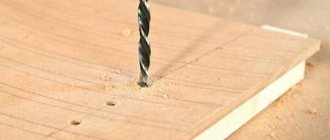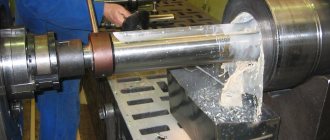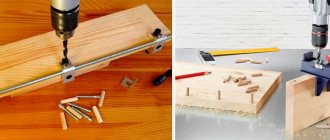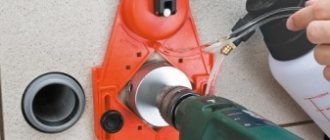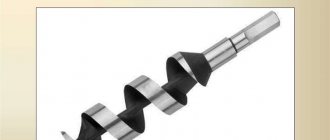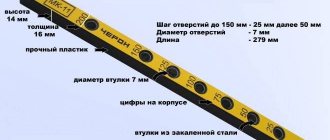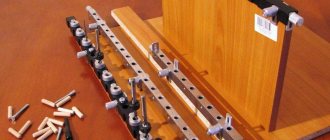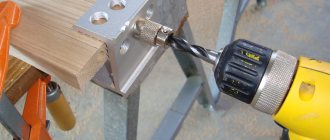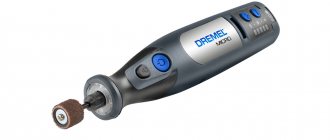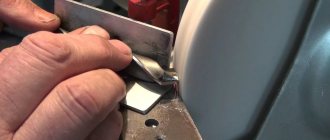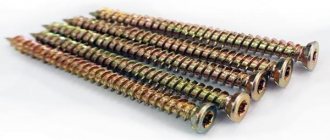Short description
A Forstner wood drill bit is not like a regular bit for metal, concrete, or plastic. It has a specific appearance, reminiscent of a drill bit. The working part consists of three zones:
- Central tip or point. This is the guide. With its help, the exact drilling location is set in the center of the circle
- Headband. It is located along the outer diameter of the working area. Consists of sharpened teeth or a solid cutting part that cuts the outline of the hole
- Paired inner edges. Pointed knives in the middle of the rim. They cut out the bulk of the wood. At its core, it is a plane that rotates clockwise along a central axis
Application area
A Forstner wood drill bit is used in combination with a hand-held electric drill or machine. Its design is designed for sampling wood with the creation of non-through recesses with a flat bottom and edges. It is used to work with hard and soft types of wood. Modern modifications are used to work with soft building materials: MDF, chipboard, fiberboard.
Forstner drills are mainly used for making furniture. In such industries, non-through holes with a smooth hole and bottom are needed. Its design makes it possible to obtain a bottom wall 1-2 millimeters thick. Such precision is not possible with simple wood bits.
Buying a Forstner drill
In order to buy a Forstner drill, you need to know not only your financial capabilities, which is also important, but also what diameters of the holes you have to drill. If you have constant work on drilling holes and have increased requirements for their quality, then you will have to purchase original drills from Connecticut Valley Manufacturing or, alternatively, from Convalco, although the price for such a drill will be equal to the price of a set of modernized drills of 6 pieces of the most popular sizes . Therefore, if your work is not frequent and there are no special complaints about the quality of the work, you can buy a set, for example, Bison, consisting of the most popular sizes.
The most popular sizes in a Forstner drill set
The Forstner drill set comes in sizes 10mm, 15mm, 20mm,25mm, 35mm. You can purchase such a set as shown in the photo in Moscow for a price starting from 672 rubles. The set does not include large diameter drills. For example, a Forstner drill of 68 mm, 70 mm or 80 mm can also be purchased at retail, and it is better to choose this size with pobedit tips. They speak well of products from the DeWolt company, the price will not put a big dent in the wallet and the quality is a solid B. You must remember that such a drill diameter causes runout at high speeds.
Forstner drill for concrete, stone
For woodworking, in particular for furniture, a Forstner wood drill with a special stop with a diameter of 35 mm is used, which is ideal for making holes for furniture hinges. The stopper helps you drill holes without the risk of drilling through the part when working manually. The drilling depth is adjusted using a special ruler on the shank.
Forstner drill bit for wood with stops
In addition, there are Forster drills for processing hard materials such as metal, stone, and ceramics. They differ from those used for wood processing in design and, most importantly, in the material from which they are made. Basically, the structure itself is made of HSS steel, and the edges are made of carbide composite materials. The principle of operation is the same as that of traditional crowns, but these drills work great with blind holes, leaving behind better walls. You just need to remember that when working with such materials you need to have constant cooling of the drill. Of course, the tool is expensive, but so far no alternative has been invented for it.
| Attention Bearing Buyers Dear customers, send your questions and requests for the purchase of bearings and components by email or call now: Delivery of bearings throughout the Russian Federation and abroad. Bearing catalog on the website |
Attention Bearing Buyers
Dear customers, send your questions and requests for the purchase of bearings and components by mail or call now: tel: +7 (495) 646 00 12 [email protected] Delivery of bearings in the Russian Federation and abroad. Bearing catalog on the website
themechanic.ru
Design and operating principle
The principle of operation of the drill is to sequentially remove wood fibers through the combined effect of its three working zones on the plane of the workpiece. The central tip bites into the workpiece, ensuring smooth rotation of the working part. The toothed rim cuts the wood to the outside diameter of the hole, creating the boundaries of the recess. Due to the intensive rotation of the head, internal knives remove wood layer by layer from the main part of the recess. The result is a geometrically smooth round hole with edges and bottom without distortion.
Wood chips are removed through the top, making it impossible for it to jam during operation. The drill can be sharpened both manually and by machine. High-strength steel is used for manufacturing, which can withstand moderate overheating and is easy to sharpen.
Many manufacturers coat the cutting parts with titanium and also weld in hard metal tips. This significantly increases the efficiency of the nozzle, reduces operating temperature and extends service life. The working edges are modernized using teeth. This design solution reduces the coefficient of friction and operating temperature of the surface, and also increases productivity.
The drill has a standard shank. Therefore, a conventional chuck for a hand-held electric drill is sufficient for operation.
Which Forstner drill is better?
How to choose the right Forstner drill so that it serves for a long time and is of high quality - this is the question asked by many beginners who are buying this type of tool for the first time.
It must be said that four main types of Forstner drills are currently produced.
Types of Forstner drills
Of those shown in the figure, drill number 1 can be classified as a real Forstner drill. This drill has a small sharp tip, the cutting edge is interrupted in two places by the main blades. This drill bit is not intended for machine sharpening and must only be sharpened by hand. Such drills are rare in our markets; they are produced in the United States. They have increased wall thickness, which protects the instrument from overheating. The holes obtained with their help are of different quality. Their price is much higher than others.
If we consider product No. 2, it belongs to a more modern type of drill. The central tip is longer, and there are cutouts in the rim located behind the inner blades, which allow the tool to be sharpened on sharpening machines. This greatly reduces operating costs.
The drill number 3 has carbide plates that are soldered to the body, as well as a soldered tip. Their price is comparable to the cost of real drills, they are not subject to overheating, last much longer than conventional modernized ones, but are subject to significant vibration during operation. This leads to the fact that the drills may break off before deepening begins; they are not recommended for drilling end holes or holes at an angle.
Drill No. 4 has special cutters on its cutting edge, which in their shape resemble the teeth of a saw. The shape of the drill itself is similar to the modernized one, but due to the fact that the sharp bit has less contact with the material, the drill overheats less during operation. This is especially good for drilling holes larger than 25mm in circumference. The disadvantage is also frequent breakdowns, especially among beginners. Therefore, it is not advisable to use on end and angled holes.
A beginner will also be interested in how to sharpen a Forstner drill. You need to remember the following rules.
Sharpening a Forstner drill
The bezel is never sharpened. Its cutting edge must be strictly in one plane, which requires special equipment for sharpening. To sharpen the internal incisors, use a small file, as in the photo, with a minimum grain size. You can use a sharpening stone or a tape. You need to start with a flat front edge, remove the burr from the back using a fine-grit sharpening stone.
The internal cutters are sharpened using a belt sharpener, and during sharpening, the front edge is pressed against the support plate along its entire plane.
Sharpening should be done in such a way that very little metal is removed per pass, especially on internal incisors, since this can change the very geometry of the edges.
Advantages
The Forstner wood drill rightfully occupies a leading position in its class. This good result is due to two factors:
- Ideal side edges and bottom for evenness. The teeth on the cutting edge cut the wood fibers before the main internal knives approach. Therefore, the tree does not tear, but is smoothly removed from the hole. High quality bottom cutting is achieved due to durable and sharpened inner edges
- Precisely maintains the direction of travel. This is achieved through a rim with teeth that allow you to cut wood efficiently. The drill follows a precisely specified path, without distortions or deviations from the axis. Even if the diameter of the hole is larger than the size of the workpiece, it will not “rotate” from the working axis
Operating rules
They are designed to make work easier and prevent injuries:
- The drill must be installed accurately. To do this, the centering point is pressed into the wood until it touches the outer edge. The nozzle operates at low speeds up to 1800 rpm. Drilling should begin at a minimum rotation speed of 800 rpm;
- The operating speed directly depends on the hole diameter. The larger it is, the less speed it needs to be drilled. This helps maintain optimal temperature on the working part of the tool;
- The Forster drill can be equipped with a depth limiter. This is a useful option designed to record the cutting depth, as well as increase safety measures during work;
- Sometimes the thickness of the material does not allow you to fully use the functionality of the tool. If the sheet of wood is too thin, the centering tip can pierce through it, then two drills are used. The first sets the direction of movement. The second has a sharpened edge. With its help, the required hole thickness is selected.
How does a Forstner drill work?
When using a Forstner drill, you need to know how to use it correctly. To do this, let's first get acquainted with its design. It has a small point for centering and two cutting edges. If you look at its profile, it more closely resembles the Latin letter S, inverted as in a mirror, or the letter Z. The cutting edge on the bridge is used to make a selection in the tree. The scoring edge is a stop that holds the drill in the hole being machined. To prevent the drill from getting jammed by chips, the special design of the product throws the chips to the top.
In addition, although many varieties of this drill are now produced, which only slightly resemble the original Forster drill, its operating principle remains the same. Modern drills of this design are made mainly from high-speed steel using casting, but the tool of the previous design, to preserve its qualities, is made from carbon steel using turning. Naturally, they are more expensive. If the workpiece is small in diameter, it is more convenient to use a drill with a small central point.
In addition, the larger the hole needs to be drilled, the lower the speed applied, which will protect the tool and material from overheating. By the way, they use an ordinary drill with a simple clamping chuck. Before starting work, mark the point to which we apply the tip. First we set the speed to low to check the correct operation. Next, select a mode from 1000 to 2000 revolutions, depending on the diameter of the drill used.
Since this drill design uses the entire cylindrical surface, it is almost impossible to move the drill to the side. This will require significant effort. In addition, this design allows the fibers to be trimmed before the cutting edge takes hold of them. This allows you to obtain a hole virtually free of burrs and scoring.
